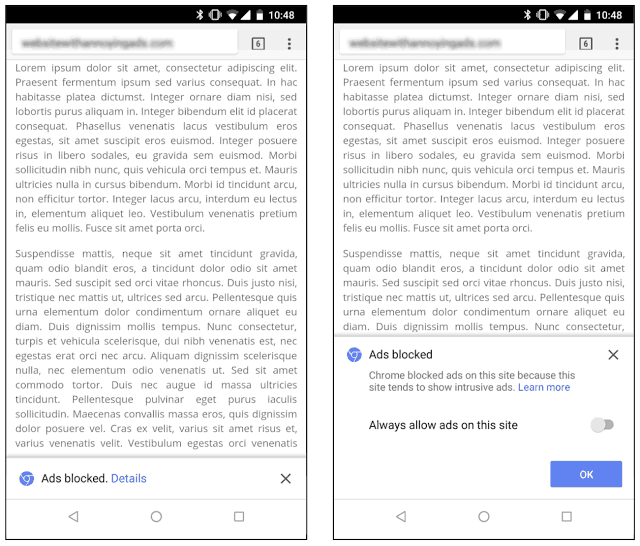Ad blocking arrived in Google’s Chrome desktop and mobile browsers on Thursday.
Google, which first announced its plans to introduce ad blocking last June, isn’t blocking all ads, just those that violate the Coalition for Better Ads’ “Better Ads Experience Program” standards. Among the 12 ad types that Chrome will ban include pop-up ads, mobile ads that cover more than 30% of a consumer’s phone screen, flashing animated ads, auto-play video ads that unexpectedly play sound and full-screen scroll-over ads.
59.3% of all web sessions on average between desktops, tablets and smartphones are via the Chrome browser, according to NetMarketShare, which tracks 100 million web sessions per month at thousands of websites.
Google will remove all ads from sites that fail to meet the Coalition for Better Ads’ standards for more than 30 days. Retailers can see if their sites are compliant with those standards using Google’s Ad Experience Report tool.
While some of the ad experiences that violate the Better Ads Standards are problems with a retailer’s ad, the majority of them—including high ad density or prestitial ads with countdown—are the fault of the site owner. That means retailers and brands need to be cognizant of where their ads appears and whether those sites comply with the new standards.
When a Chrome user navigates to a page, Chrome’s ad filter will first check if that page belongs to a site that fails the Coalition for Better Ads’ standards. If it doesn’t, Chrome will automatically block the ads. When at least one network request has been blocked, Chrome will show the user a message that indicates an ad has been blocked. The user can then select “allow ads on this site.”
For desktop users, the notification in Chrome’s address bar will look similar to Chrome’s existing pop-up blocker. Android users will see the message in a small infobar at the bottom of their screen. They can then tap Details to see more information and override the default setting.

Chrome will automatically block ads that violate the Better Ads Standards. However, users can disable the feature by selecting “allow ads on this site.”
Google says its goal is to improve the quality of the digital ads which, in turn, may produce a better experience for all web users. As of Feb. 12, 42% of sites that initially failed the Better Ads standards resolved their issues and are now passing, which enables ads to render on their sites.
“This is the outcome we are were hoping for—that sites would take steps to fix intrusive ads experiences themselves and benefit all web users,” writes Chris Bentzel, Google engineering manager, in a blog post.
However, not everyone is convinced there’s a need for Google’s efforts.
“The balance between ads and revenue is a symbiotic ecosystems that needs to stay balanced,” says Michael Priem, founder and CEO at advertising firm Modern Impact. “There is scores of data and research that shows that consumers only engage with relevant and meaningful ads, and publishers are continuously pressed to create good ad inventory. The present ad blockers cannot disrupt this balance or ultimately consumers will have to open their wallets, or disable their ad blockers.”